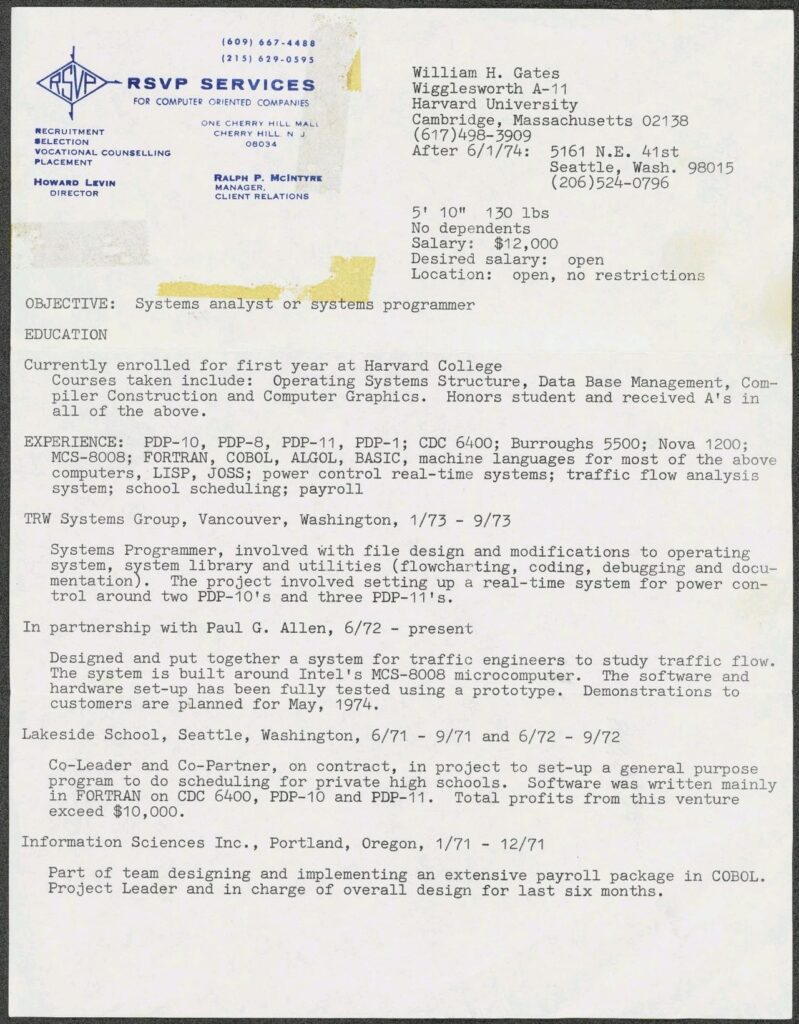
In the early 1970s, a young and driven individual named William H. Gates had his sights set on the rapidly evolving world of computer systems and programming. His resurfaced job application provides a fascinating snapshot of his aspirations, achievements, and experiences during that era. Known as Bill Gates, he later became the co-founder of Microsoft and a renowned philanthropist. He briefly attended Harvard University before dropping out to pursue the development of Microsoft. As we delve into this historical document, we gain insights into the foundation of a career that would ultimately reshape the technology landscape and inspire generations of innovators.
Gates’ application reveals a driven and capable individual. His academic pursuits at Harvard University, even in his freshman year, showcased a deep understanding of computer science. Enrolled in a range of courses including Operating Systems Structure, Compiler Construction, and Computer Graphics, he achieved remarkable A grades in all. This dedication to learning and mastery is a trait that has transcended time and continues to be a cornerstone of successful tech careers today.
One of the most striking aspects of Gates’ application is his familiarity with a diverse array of computer systems and programming languages. His experience with PDP-10, PDP-8, CDC 6400, and more, along with languages like FORTRAN, COBOL, and LISP, underscores his adaptability and versatility. In a world where technology ecosystems continue to evolve, the ability to learn new systems and languages remains a vital skill. Today’s developers, too, find themselves constantly learning to stay relevant in an ever-changing landscape.
Gates’ involvement in various projects, such as his work on real-time power control systems and traffic flow analysis, showcases his capacity for hands-on problem-solving. His partnership with Paul G. Allen to design a traffic flow analysis system demonstrates the power of collaboration, an aspect that’s become even more pertinent in today’s era of complex and interconnected technologies. As modern projects grow in complexity, interdisciplinary teamwork becomes key to success.
Furthermore, Gates’ entrepreneurial spirit is evident in his co-leadership of a project that generated substantial profits from scheduling software. This entrepreneurial drive, which characterized Gates’ later years as he co-founded Microsoft, highlights the enduring importance of innovation and market awareness in the technology industry.
As we compare Gates’ early career aspirations and achievements to the present era, several intriguing parallels and divergences emerge. While technological progress has been extraordinary, certain constants remain. Dedication to learning, adaptability to new technologies, and the ability to collaborate effectively are still highly valued traits. However, the scale and complexity of projects have grown immensely, as evidenced by the transformative potential of artificial intelligence, quantum computing, and biotechnology, among others.
The modern tech landscape is also characterized by a strong emphasis on ethics, diversity, and social responsibility, elements that have grown in prominence since the 1970s. Today’s tech leaders are not only expected to drive innovation but also to consider the ethical implications of their creations and work towards inclusive solutions that benefit society at large.
Bill Gates’ early career aspirations and experiences, as encapsulated in his historical job application, serve as a captivating lens through which we can reflect on the past and compare it to the present. The technology industry has come a long way, but the qualities that enabled Gates’ success—curiosity, adaptability, innovation—remain as relevant as ever. As we navigate the complexities of our modern era, we can draw inspiration from the foundations laid by pioneers like Gates and strive to shape technology for a better and more inclusive future.

